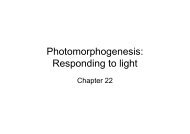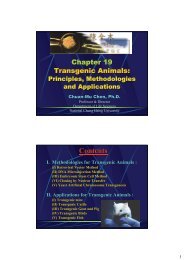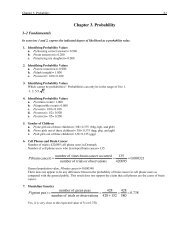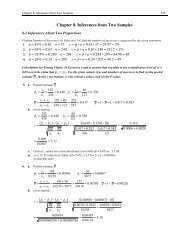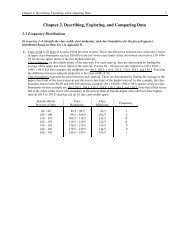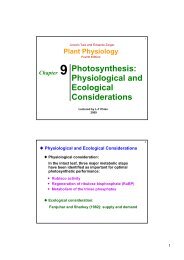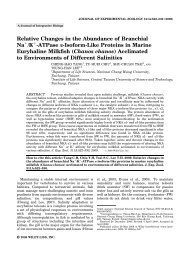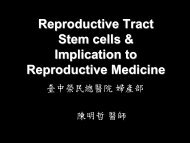Chapter 7. Hypothesis Testing with One Sample
Chapter 7. Hypothesis Testing with One Sample
Chapter 7. Hypothesis Testing with One Sample
Create successful ePaper yourself
Turn your PDF publications into a flip-book with our unique Google optimized e-Paper software.
<strong>Chapter</strong> 7: <strong>Hypothesis</strong> <strong>Testing</strong> <strong>with</strong> <strong>One</strong> <strong>Sample</strong> 205Multiplying each side by n , and then solving for n, we find0.3 n − 0.38494 = 0.4 n − 0.80588−0.1 n =−0.42094n = 1<strong>7.</strong>7So the required sample size is n = 18.7-3 <strong>Testing</strong> a Claim About a Proportion1. Mendel’s Hybridization Experimentsa. The sample proportion is p ˆ = 0.2494 , the claim is that the proportion is 0.25, so p = 0.25. The sample sizeis n = 8023. The requirements are met, since np = 8023× 0.25 = 2005.75. and nq = 8023× 0.75 = 601<strong>7.</strong>25.The test statistic isz = p ˆ − p 0.2494 − 0.25= =−0.124pq 0.25× 0.75n 8023b. The significance level is 0.05, and the claim is that the proportion is 0.25, making this a two tailed test. Thecritical values are ±z α /2=±z .025=±1.96.c. Since this is a two tailed test <strong>with</strong> test statistic to the left of center, the P-value is twice the area to the left ofthe test statistic. This area is found using Table A-2, and is 0.4522. So, P − value = 2 × 0.4522 = 0.9044 .d. Since the P-value is larger than the significance level, we would fail to reject H 0 . The conclusion is: Thereis not sufficient evidence to warrant the rejection of the claim that the proportion of green-flowered peas is0.25.e. No. A hypothesis test can only demonstrate sufficient evidence that a parameter is not a specified value, notthat the parameter is some value.2. Survey of Drinkinga. The sample proportion is p ˆ = 0.62, the claim is that the proportion is 0.50, so p = 0.50. The sample size is n= 108<strong>7.</strong> The requirements are met, since np = 1087 × 0.50 = 543.5. and nq = 1087 × 0.50 = 543.5. The teststatistic isz = p ˆ − p 0.62 − 0.50= = <strong>7.</strong>913pq 0.50 × 0.50n 1087b. The significance level is 0.05, and the claim is that the proportion greater than 0.50, making this a righttailed test. The critical value is z α= z .05= 1.645.c. Since this is a right-tailed test <strong>with</strong> test statistic to the right of center, the P-value is the area to the right ofthe test statistic. This area is found using Table A-2, and is 0.0001. So, P − value = 0.0001.d. Since the P-value is smaller than the significance level, we would reject H 0 . The conclusion is: The sampledata support the claim that the majority of adults use alcoholic beverages.e. No. Small sample sizes in similar tests could have results that do not cause us to reject H 0 .In Exercises 3-6, assume that a method of gender selection is being tested <strong>with</strong> couples wanting to have babygirls. Identify the null hypothesis, alternate hypothesis, test statistic, P-value or critical value(s), conclusion aboutthe null hypothesis, and final conclusion that addresses the original claim. Use the P-value method unless yourinstructor specifies otherwise.3. The claim is that the proportion of girls born using the method is greater than 0.50, so this is a right tailed test.The sample size is n = 100 and the number of births that were girls was x = 65, so p ˆ = 65/100 = 0.65. Thesignificance level is 0.01.H 0 : p = 0.50H 1 : p > 0.50




